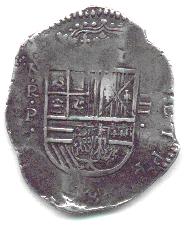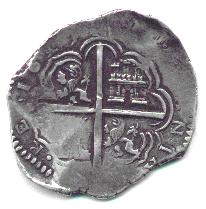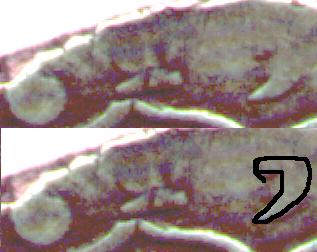
| Philip
IV / Felipe IV
#1852: 8 Reales 1627 P Nuevo Reino 26.759 grams / gramos. Click image to enlarge / Haz clic la imagen para agrandarla | |
Obverse: Crowned Habsburg shield, with small triangle at bottom. The lions and castles for Castile and Leon are swapped. To the right of the shield is the vertical numeral VIII, for the denomination, reading downward. To the left of the shield is NRP: NR is the mint mark for Nuevo Reino and P is the assayer mark for Miguel Pinto Camargo. The legend around the periphery reads: "(PHI)LIPP(VS · IIII · D · G)". Reverse: Cross surrounded by 8 arcs. In the quarters of the cross are castles and lions, for Castile and Leon, again swapped from the correct location. The legend around the periphery reads "(HISP)ANIA(RVM) · RE(X) · 1627". R/L M44-6, L/R M44S-6, C&T Type 103, number 523. Anverso: Escudo de Hasburgo, coronado con un pequeño triángulo en la base. Los castillos y leones, por Castilla y León, están en posición cambiada. Hacia la derecha del escudo se encuentra un numeral VIII en posición vertical y se lee hacia abajo. Hacia la izquierda está NRP: NR es la marca de ceca de Nuevo Reino y P es la marca de ensayador de Miguel Pinto Camargo. La leyenda alrededor, en la periferia, dice: "(PHI)LIPP(VS · IIII · D · G)" . Reverso: Cruz rodeada por 8 arcos. En los cuarteles hay castillos y leones, por Castilla y León de nuevo en posición cambiada. La leyenda de la periferia dice: "(HISP)ANIA(RVM) · RE(X) · 1627" R/L M44-6, L/R M44S-6, C y T Tipo 103, numero 523. |
|
This beautiful 8 reales is of the classic Habsburg shield design, struck on a large planchet 45 mm high by 36 mm wide. The obverse shows a full shield, mintmark and assayer. Of interest is the feature that there is no inner ring of pearls or dots around the shield, it has a ring only on the periphery (outer edge) of the obverse design. Usually there are two rings of dots, one on the inside of the peripheral legend and the other on the outside of the peripheral legend. The 1622 pieces attributed to Nuevo Reino and to Cartagena have only one ring of dots, and this is along the outside of the legend. After 1622 the only other Nuevo Reino 8 reales which we can identify as having no inner ring is a 1627 NRP (Calbetó 1342,3) and a second NRP piece on which the date is not visible (Calbeto 1340, R/L M44-9). We believe that the second piece is also 1627 based upon the style and the backward denomination which reads IIIV. The reverse of the coin has a 4 digit date, very rare on a Nuevo Reino coin. We thought at first that the date was 1627, then after starting our research thought it might be 1625, but after many days of poring through reference works and of studying the coin, we conclude that it is indeed 1627, and that the references to a 1625 piece are in error due to mis-interpretation of a photograph. Estos bellos ocho reales son del diseño clásico, acuñado sobre un cospel grande de 45 mm de altura por 36 mm de ancho. El anverso muestra un escudo completo con marca de ceca y de ensayador. Es interesante el hecho de que no tiene un anillo interno de perlas o puntos, lo tiene sólo en la periferia del diseño del anverso. Usualmente aparecen dos anillos de puntos, uno hacia dentro de la leyenda periférica y otro por fuera de la misma. Las piezas de 1622 atribuidas a Nuevo Reino y a Cartagena tienen solamente un anillo de puntos por fuera de la leyenda. Los únicos ejemplares posteriores a 1622 que no tienen anillo interno son uno de 1627 NRP (Calbetó 1342,3) y otro NRP cuya fecha no es visible (Calbetó 1340, R/L M44-9). Creemos que la segunda es también de 1627 basados en el estilo y en que la denominación (IIIV) está al revés. El reverso de la moneda tiene fecha de cuatro dígitos lo cual es raro en piezas de Nuevo Reino. Nuestra primera impresión es que era de 1627, cuando empezamos a investigarla creímos que era de 1625 pero terminamos concluyendo que realmente es de 1627, y que las referencias a la pieza con fecha de 1625 están en el error debido a la interpretación de una fotografía. |
|
|
|
|
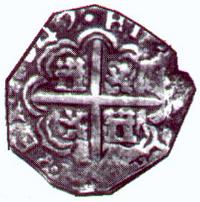
R/L M28-21 1647 2 Reales * |

R/L M28-9 1627 2 Reales * |
Also of significance is the lion's tail on the reverse. The tail does not have the usual curve, compare to typical Nuevo Reino 8 reales lion. Observe also the flat "points" of the double arcs. Dr. Restrepo believes that this is due to filled dies rather than not having been punched by the die sinker, I am sure he is correct because you can see traces of the tail. También es significativa la cola del león en el reverso. La cola no tiene la curvadura usual si se compara con los leones típicos de los 8 reales de Nuevo Reino. Obsérvense también las "puntas" planas de los arcos dobles. Dr. Restrepo cree que estos son troqueles embotados, yo soy cierto que él está correcto porque usted puede ver los rastros de la cola. |
|
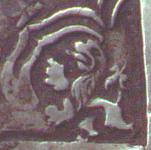
#1852: 8 Reales - 1627 |
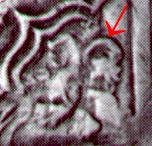
R/L M44-15 - 8 Reales 1634 * |
* Images from Restrepo/Lasser used with permission of Dr. Restrepo. See reference page for publication data.
* Las imágenes de Restrepo/Lasser son usadas con autorización del doctor Restrepo. Véase la página de referencia sobre los datos de la publicación.
©Copyright Herman Blanton 2002, all rights reserved.


